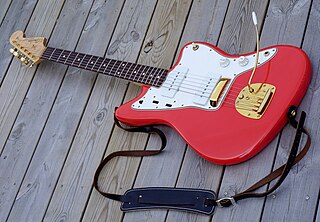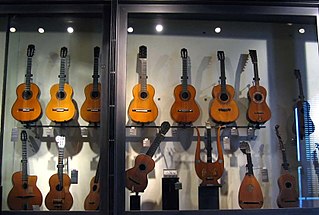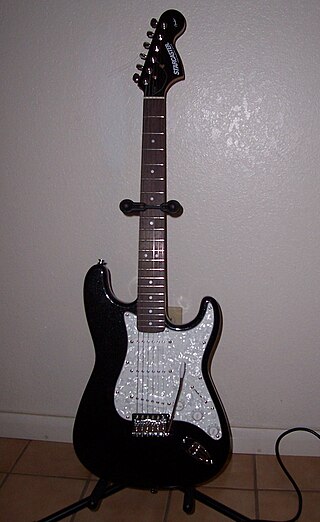
An electric guitar is a guitar that requires external amplification in order to be heard at typical performance volumes, unlike a standard acoustic guitar. It uses one or more pickups to convert the vibration of its strings into electrical signals, which ultimately are reproduced as sound by loudspeakers. The sound is sometimes shaped or electronically altered to achieve different timbres or tonal qualities from that of an acoustic guitar via amplifier settings or knobs on the guitar. Often, this is done through the use of effects such as reverb, distortion and "overdrive"; the latter is considered to be a key element of electric blues guitar music and jazz, rock and heavy- metal guitar playing. Designs also exist combining attributes of the electric and acoustic guitars: the semi-acoustic and acoustic-electric guitars.
Ibanez is a Japanese guitar brand owned by Hoshino Gakki. Based in Nagoya, Aichi, Japan, Hoshino Gakki were one of the first Japanese musical instrument companies to gain a significant foothold in import guitar sales in the United States and Europe, as well as the first brand of guitars to mass-produce the seven-string guitar and eight-string guitar. Ibanez manufactures effects, accessories, amps, and instruments in Japan, China, Indonesia, and the United States. As of 2017 they marketed nearly 165 models of bass guitar, 130 acoustic guitars, and more than 300 electric guitars. After Gibson and Fender, Ibanez is considered the third biggest guitar brand.

A guitar amplifier is an electronic device or system that strengthens the electrical signal from a pickup on an electric guitar, bass guitar, or acoustic guitar so that it can produce sound through one or more loudspeakers, which are typically housed in a wooden cabinet. A guitar amplifier may be a standalone wood or metal cabinet that contains only the power amplifier circuits, requiring the use of a separate speaker cabinet–or it may be a "combo" amplifier, which contains both the amplifier and one or more speakers in a wooden cabinet. There is a wide range of sizes and power ratings for guitar amplifiers, from small, lightweight "practice amplifiers" with a single 6-inch speaker and a 10-watt amp to heavy combo amps with four 10-inch or four 12-inch speakers and a 100-watt amplifier, which are loud enough to use in a nightclub or bar performance.

The Fender Jazzmaster is an electric guitar designed as a more expensive sibling of the Fender Stratocaster. First introduced at the 1958 NAMM Convention, it was initially marketed to jazz guitarists, but found favor among surf rock guitarists in the early 1960s. Its appearance is similar to the Jaguar, though it is tonally and physically different in many technical ways, including pickup design, scale length and controls.
The Fender Jaguar is an electric guitar by Fender Musical Instruments characterized by an offset-waist body, a relatively unusual switching system with two separate circuits for lead and rhythm, and a short-scale 24" neck. Owing some roots to the Jazzmaster, it was introduced in 1962 as Fender's feature-laden top-of-the-line model, designed to lure players from Gibson. During its initial 13-year production run, the Jaguar did not sell as well as the less expensive Stratocaster and Telecaster, and achieved its most noticeable popularity in the surf music scene. After the Jaguar was taken out of production in 1975, vintage Jaguars became popular first with American punk rock players, and then more so during the alternative rock, shoegazing and indie rock movements of the 1980s and 1990s. Fender began making a version in Japan in the mid-1980s, and then introduced a USA-made reissue in 1999. Since then, Fender has made a variety of Jaguars in America, Mexico, Indonesia and China under both the Fender and Squier labels. Original vintage Jaguars sell for many times their original price.

The Fender Precision Bass is a model of electric bass guitar manufactured by Fender Musical Instruments Corporation. In its standard, post-1957 configuration, the Precision Bass is a solid body, four-stringed instrument usually equipped with a single split-coil humbucking pickup and a one-piece, 20-fret maple neck with rosewood or maple fingerboard.

Mosrite is an American guitar manufacturing company, based in Bakersfield, California, from the late 1950s to the early 1990s. Founded by Semie Moseley, Mosrite guitars were played by many rock and roll and country artists.

Anders Niklas Andersson, also known as Nicke Andersson, is a Swedish musician best known as the singer and guitarist for the rock band The Hellacopters and drummer for the death metal band Entombed. Besides his work with the Hellacopters and Entombed, Andersson currently plays and writes songs for the soul band The Solution, the death metal band Death Breath, the hard rock band Lucifer, and rock band Imperial State Electric.

Seymour Duncan is an American company best known for manufacturing guitar and bass pickups. They also manufacture effects pedals which are designed and assembled in America. Guitarist and luthier Seymour W. Duncan and Cathy Carter Duncan founded the company in 1976, in Santa Barbara, California.

The following outline is provided as an overview of and topical guide to guitars:

The Fuzz Face is an effects pedal for electric guitar, used also by some electric bass players. It is designed to produce a distorted sound referred to as "fuzz", originally achieved through accident such as broken electrical components or damaged speakers.

Distortion and overdrive are forms of audio signal processing used to alter the sound of amplified electric musical instruments, usually by increasing their gain, producing a "fuzzy", "growling", or "gritty" tone. Distortion is most commonly used with the electric guitar, but may also be used with other electric instruments such as electric bass, electric piano, synthesizer and Hammond organ. Guitarists playing electric blues originally obtained an overdriven sound by turning up their vacuum tube-powered guitar amplifiers to high volumes, which caused the signal to distort. While overdriven tube amps are still used to obtain overdrive, especially in genres like blues and rockabilly, a number of other ways to produce distortion have been developed since the 1960s, such as distortion effect pedals. The growling tone of a distorted electric guitar is a key part of many genres, including blues and many rock music genres, notably hard rock, punk rock, hardcore punk, acid rock, and heavy metal music, while the use of distorted bass has been essential in a genre of hip hop music and alternative hip hop known as "SoundCloud rap".

The Univox Hi-Flier is an electric guitar marketed and sold by Univox from roughly 1967 to 1977. With its reversed offset body, the Hi-Flier has an intentional resemblance to the Mosrite Ventures model. A bass version of the Hi-Flier was also available.

Bass effects are electronic effects units that are designed for use with an electric bass and a bass amplifier, or for an upright bass and a bass amp or PA system. Bass effects are commonly available in stompbox-style pedals, which are metal or plastic boxes with a foot-operated pedal switch or button which turns the effect on and off. Most pedals also have knobs to control the tone, volume and effect level. Some bass effects are available in 19" rackmount units, which can be mounted in a road case. As well, some bass amplifiers have built-in effects, such as compression, overdrive or chorus.

Duesenberg is a brand for electric string instruments founded in 1986 and located in Hannover, Germany. The headquarter is in Hannover, Germany, they are known for using a Plek machine for the levelling of frets and setup. Duesenberg has uploaded a factory production video of how their guitars are made, revealing that most of the production of the guitars is done in Croatia, while the final setup and assembly is done in Germany.

Starcaster by Fender is a range of instruments and accessories aimed at students and beginners, marketed by the Fender Musical Instruments Corporation from the early 2000s until at least 2011. As of April 2018, no products were being marketed under this brand.
BJFE Guitar Effects is a company which manufactures effects pedals for use with instruments such as an electric guitar. These pedals are commonly used by guitarists to modify the sound of their guitar before it reaches the amp. The company is located in Sweden, and was founded in 2000 by Björn Juhl. "BJFE" stands for Björn Juhl Förstärkarelektronik. Pedal types include distortion, overdrive, "vibe" (vibrato), compression, and equalization (EQ). Due to the limited production and handbuilt nature, these pedals are considered "boutique" guitar effects.

The Peavey EVH Wolfgang guitar series is a collaboration between guitarist Eddie Van Halen and Hartley Peavey's company, Peavey Electronics. The EVH stands for "Eddie Van Halen" while Wolfgang is the name of Eddie Van Halen's son.
The Fender Telecaster, colloquially known as the Tele, is an electric guitar produced by Fender. Together with its sister model the Esquire, it was the world's first mass-produced, commercially successful solid-body electric guitar. Its simple yet effective design and revolutionary sound broke ground and set trends in electric guitar manufacturing and popular music.

The Maestro FZ-1 Fuzz-Tone was the first widely marketed fuzz distortion guitar and bass effect. Introduced in 1962, it achieved widespread popularity in 1965 after the Rolling Stones guitarist Keith Richards prominent use of the FZ-1 on the group's hit, "Satisfaction". Later in 1965 the design was slightly modified, designated as the model FZ1-1a. In the wake of the success of the Rolling Stones' "Satisfaction," numerous recordings mostly from 1960s garage rock and psychedelic acts featured Maestro Fuzz-Tones on guitars. More significant design changes made after 1967 resulted in different renditions of the Fuzz-Tone released over the years. In the 1990s Gibson re-issued FZ-1a, but it was later discontinued.
















